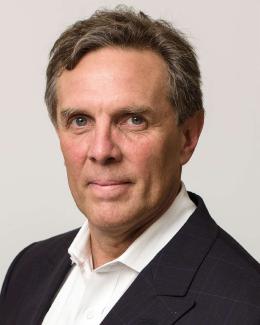Though Doug Farr is a native Detroiter and lives in Chicago, he always wanted to live in the Bay Area. “I applied to Stanford for undergrad and to Cal for grad school but was rejected both times,” he told us in a recent email. “So I settled for being a member of SPUR.”
In addition to being a SPUR member, he runs Farr Associates, a sustainability-focused architecture and urban design firm and describes himself as “a perpetual volunteer.” He serves on not one but three boards, EcoDistricts, Elevate Energy and Illinois Green, and is former board chair of the Congress for the New Urbanism. “My professional practice and board service constitute a coherent body of work around accelerating good change,” he explains. “But I admit to being nagged by questions about whether the change I am working toward can happen with the urgency I feel is needed.”
Somehow, despite all these commitments, he also managed to write a book, just released.
Tell us about your new book.
Sustainable Nation: Urban Design Patterns for the Future, the result of nearly three years of research and writing, is a deep dive into how long change takes and how to speed it up. The book has an epic arc and an optimistic thesis. Thanks to science and technology, for the first time in history we can document the challenges society faces and track our progress in tackling them across generations. [It is my hope that] everyone can become leaders adept at deploying combinations of six proven change accelerants — strategies such as campaigns, pilgrimage sites, heuristic hacks and urban design patterns. [If so,] we can tackle the country’s great challenges, like reversing obesity and decarbonizing our economy within 100 years, or four generations. Even to a sophisticated Bay Area audience, the book should inspire, surprise and stir debate. The highlight of the book is a collection of 70 “Patterns for the Future,” inspired by Chris Alexander’s A Pattern Language. These brief word stories are designed to steer the on-the-ground work of community leaders, planners, developers and local government. Peter Calthorpe had this to say: “Sustainable Nation is the neighborhood operating manual we need to speed up change across the world.”
What is a “neighborhood checkup”?
Checkups are featured in the chapter called “Self-Governing Neighborhoods,” written by Jessica Millman. It reads, “Maintain the health of your neighborhood by holding annual planning checkups.” The Sustainable Nation framing is that the U.S. is a country of perhaps half a million neighborhoods that are a largely untapped platform for driving national progress. Millman’s pattern is a prompt for each and every U.S. neighborhood to start nonvirtual, face-to-face conversations about self-governance, planning and change.
What first got you interested in cities, and how did you first learn about SPUR?
I had an ideal childhood growing up in Detroit in the 1970s attending Cass Technical High School downtown. My route home from school was to walk through Grand Circus Park and along Woodward to my bus stop. Grand old buildings were being torn down every year. While it made me sad, my pride for Detroit fired me up to want to work on improving cities. I first learned about SPUR from my friend John Ellis, an architect at Solomon ETC/ Mithun. We were talking one day and he was describing to me how cool one of his clients was. To drive home the point, he mentioned she was on the board of SPUR. The rest is history.
What’s your favorite urban view?
The Chicago skyline at dusk, swimming in Lake Michigan, next to a sailboat, three miles offshore. From this vantage you can see Navy Pier, a miles-long street wall, the volume of Grant Park, the Hancock Building, and every harbor and lakefront museum. It is spectacular!
Favorite city?
Charleston, South Carolina. Great walking city, gorgeous waterfront, amazing history, incredible food, unique regional architecture, and the best-ever (former) mayor, Joe Riley.
Favorite book about cities (other than your own)?
Wacker’s Manual of the Plan of Chicago, written in 1911, was a required text for eighth-grade public school students. It taught the history of city planning and explained to teens their role as future stewards of the built environment. The foresightedness of training future generations to implement the Burnham Plan (which is thought to be only about 30 percent done after 100 years) just blows me away.

